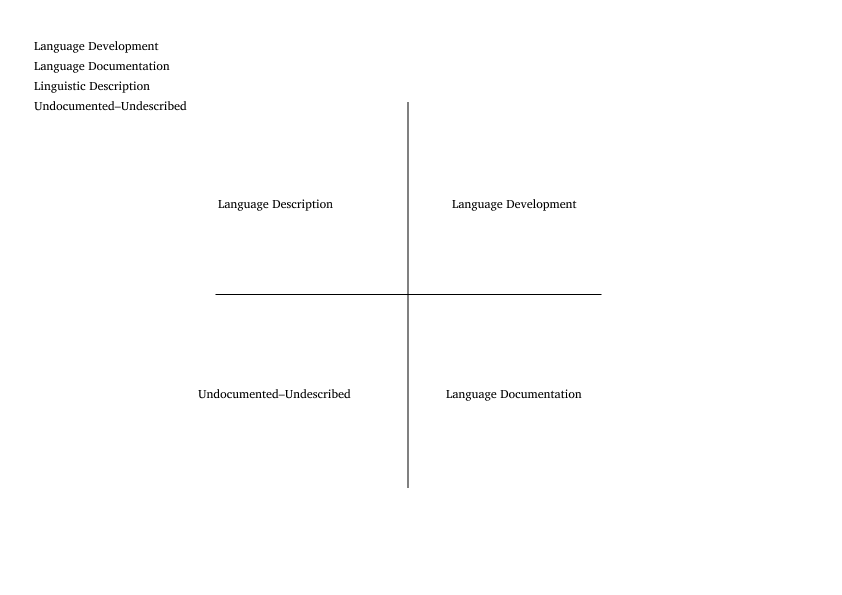I’m wondering what approaches to classifying language resources exist with regard to the purpose of the language resource’s creation. I’ve sketched out the following basic categories. Do these make sense? Are there alternative approaches (if so what are they)? Do these categories make sense as distinct categories?
I’m curious as to what the audience of the classification is? Would this be meant to guide people through annotated bibliographies? Or added as tags in archives? Personally, I would find it difficult to classify resources with this schema, as I see all of these as interlinked.
Also, if I may ask further questions, what do you mean by the category ‘Undocumented-Undescribed’ as opposed to the others?
Great questions. I’ll try to explain, bear with me. Please let me know if this helps or muddies the waters, and how it helps or muddies the waters. As you say these are not clear categories to you, but what are the clear categories for you?
I’m sure you might agree about the difference between an undocumented-undescribed language and one which has some documentation and or description… If I am not mistaken the concept of a doculect speaks to this issue. For example, I see this in a lot of grant applications… the “undocumented language X” inferring that there is are not records in this language which may be used as primary sources.
- Cysouw, Michael, and Jeff Good. 2013. “Languoid, Doculect and Glossonym: Formalizing the Notion ‘Language.’” Language Documentation & Conservation 7: 331–59. https://hdl.handle.net/10125/4606.
I think the second contrast I was hoping to make clearer is found in the literature via Himmelman’s works where a distinction exists between documentation and description:
-
Himmelmann, Nikolaus P. 1998. “Documentary and Descriptive Linguistics.” Linguistics 36 (1): 161–95. doi:10.1515/ling.1998.36.1.161.
-
———. 2012. “Linguistic Data Types and the Interface between Language Documentation and Description.” Language Documentation & Conservation 6 (1): 187–207. http://hdl.handle.net/10125/4503.
Finally, the fourth category “Development”. Is (and if you can verify) perhaps where you might have gotten hung up. Ferguson (and Fishman) talk about language development in terms of intentional steps taken to ensure the continued use of a language. This has some overlap with ideas presented today under the label “revitalization”.
-
Fishman, Joshua A. 1968. “Language Problems and Types of Political and Socio-Cultural Integration: A Conceptual Postscript.” In Report on the Ninth International Conference on Second Language Problems, Tunis, 24–27 April. London, England: English-Teaching Information Centre. ERIC - ED025739 - Language Problems and Types of Political and Socio-Cultural Integration: A Conceptual Postscript., 1968-Apr-9.
-
———. 1980. “Ethnocultural Dimensions in the Acquisition and Retention of Biliteracy.” Journal of Basic Writing 3 (1): 48–61. doi:10.37514/JBW-J.1980.3.1.05.
-
Ferguson, Charles A. 1968. “Language Development.” In Language Problems of Developing Nations, edited by Joshua A. Fishman, Charles A. Ferguson, and J. Das Gupta, 27–36. New York: Wiley and Sons.
-
Obiero, Ogone John. 2010. “From Assessing Language Endangerment or Vitality to Creating and Evaluating Language Revitalization Programmes.” Nordic Journal of African Studies 19 (4): 201–26.
Thanks for the clarifications. I understand what you mean by these terms, but my question is where you want to apply this classification? Are you planning a meta-repository of documentation resources where each resource would be tagged like this (something like extended Glottolog)? Is this for tagging resources in archives? If so, which ones? Is this for funding schemes?
Sorry if I wasn’t clear with my question. I wanted to ask what the classification would be used for, because not knowing makes it difficult to assess and interpret the categories.
